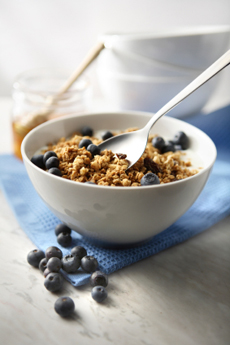

Granola with fresh blueberries. Photo by Floortje | IST.
|
STEPHANIE ZONIS is a contributing editor.
|
|
January 2012
|
 |
Page 2: What Is Granola Cereal
Defining Granola And Muesli, And Little History
This is Page 2 of a seven-page-plus article on granola cereal, and reviews of 44 granola cereal brands and nine muesli brands. Click on the black links below to visit other pages.
What Is Granola Cereal?
There is no legal definition for either granola or muesli in the United States. This complicates matters somewhat, as a manufacturer can produce literally anything, put it into a bag or box, and label it as one of these two foods.
According to the Oxford American Dictionary, granola is “a kind of breakfast cereal consisting typically of rolled oats, brown sugar or honey, dried fruit, and nuts.” Muesli (the word is Swiss-German in origin) is defined as “a mixture of oats and other cereals, dried fruits, and nuts, eaten with milk at breakfast.”
The Differences Between Granola & Muesli
The chief differences between these two foods (which can be eaten at times other than breakfast) are that historically, granola has been baked or toasted, while muesli consists of unbaked, untoasted oats or other cereal grains, dried fruits and nuts.
- In addition, granola typically has sweetening added (that sweetening can be anything from brown rice syrup to refined sugar), and some granolas have added fat.
- It’s rare for a muesli to have either sweetener or fat.
- All mueslis have oats; not all granolas do. While I have yet to find a muesli that is oat-free, some granola makers now eschew the use of oats. For instance, raw food devotées can choose from a number of “raw” granolas. Those I’ve encountered do not contain oats, but use sprouted, dehydrated buckwheat as their base. (Technically, buckwheat is an herb.) Presumably, there may be other granolas that do not use oats as well.
- Additionally, some granolas do not use fruit, some do not contain nuts, and a few I’ve encountered don’t have either.
The History Of Granola & Muesli
Both granola and muesli were invented as healthy food alternatives by doctors at sanatoriums: Granula (later copied and called Granola) in upstate New York in 1863, and muesli in the late 1890s in Zurich, Switzerland. Granula was the world’s first dry, manufactured breakfast cereal. Both muesli and granola recipes sold these days are a far cry from the original formulation.
- Granula was invented by Dr. James Caleb Jackson. At the time, the standard American breakfast was a cholesterol-laden hot meal of eggs, bacon, sausage and beef or chicken, plus cooked grains (hot cereal), biscuits, toast, butter and jam. For a healthier breakfast, Jackson baked nuggets from bran-rich Graham flour, which were enjoyed with milk and fruit. More granola history.
- Muesli was invented by a Swiss physician, Maximilian Bircher-Benner (this is why it is sometimes called “Birchermuesli”). In contrast to prevalent opinions about nutrition in the late 19th and early 20th centuries, Bircher-Benner advocated a diet heavy in uncooked fruits, vegetables and nuts. Muesli itself is supposedly based on a dish he and his wife encountered among Alpine shepherds. More muesli history.
Both can be enjoyed as a cold cereal with milk, with yogurt and/or fresh fruit, or heated into a porridge.
Despite the fact that muesli remains relatively unknown in the U.S., it is much-beloved in Europe, Australia and New Zealand. It is typically mixed with milk, yogurt or fruit juice before consuming.
Continue To Page 3: Types Of Granola & Muesli
Go To Article Index Above

|




